 W
WNimrod is a biblical figure mentioned in the Book of Genesis and Books of Chronicles. The son of Cush and therefore a great-grandson of Noah, Nimrod was described as a king in the land of Shinar (Mesopotamia). The Bible states that he was "a mighty hunter before the Lord [and] ... began to be mighty in the earth". Later extra-biblical traditions identified Nimrod as the ruler who commissioned the construction of the Tower of Babel, which led to his reputation as a king who was rebellious against God.
 W
WUruk, also known as Warka, was an ancient city of Sumer situated east of the present bed of the Euphrates River on the dried-up ancient channel of the Euphrates 30 km (19 mi) east of modern Samawah, Al-Muthannā, Iraq.
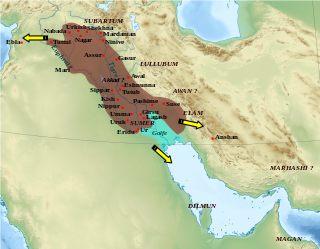 W
WAkkad was the name of a Mesopotamian city and its surrounding area. Akkad was the capital of the Akkadian Empire, which was the dominant political force in Mesopotamia during a period of about 150 years in the last third of the 3rd millennium BC.
 W
WThe Akkadian Empire was the first ancient empire of Mesopotamia after the long-lived civilization of Sumer. It was centered in the city of Akkad and its surrounding region. The empire united Akkadian and Sumerian speakers under one rule. The Akkadian Empire exercised influence across Mesopotamia, the Levant, and Anatolia, sending military expeditions as far south as Dilmun and Magan in the Arabian Peninsula.
 W
WIn the Hebrew Bible, Amraphel was a king of Shinar in Book of Genesis Chapter 14, who invaded Canaan along with other kings under the leadership of Chedorlaomer, king of Elam. Chedorlaomer's coalition defeated Sodom and the other cities in the Battle of the Vale of Siddim.
 W
WBabylon was the ancient city where some of the most influential empires of the ancient world ruled. It was the capital of the Babylonian Empire and it was considered to be a center of commerce, art, and learning and is estimated to have been the largest early city in the world, perhaps the first to reach a population above 200,000.
 W
WThe Bible: In the Beginning... is a 1966 American-Italian religious epic film produced by Dino De Laurentiis and directed by John Huston. It recounts the first 22 chapters of the Biblical Book of Genesis, covering the stories from The Creation and Adam and Eve to the binding of Isaac. Released by 20th Century Fox, the film was photographed by Giuseppe Rotunno, and Ernst Haas shot the opening creation sequence, in Dimension 150, a variant of the 70mm Todd-AO format. It stars Michael Parks as Adam, Ulla Bergryd as Eve, Richard Harris as Cain, John Huston as Noah, Stephen Boyd as Nimrod, George C. Scott as Abraham, Ava Gardner as Sarah, and Peter O'Toole as the Three Angels.
 W
WDesert God is a novel by author Wilbur Smith first published in 2014. It is part of a series of novels by Smith set to Ancient Egypt and follows the fate of the Egyptian Kingdom through the eyes of Taita, a multi-talented and highly skilled eunuch slave.
 W
WEnmerkar was an ancient Sumerian ruler to whom the construction of Uruk and a 420-year reign was attributed. According to literary sources, he led various campaigns against the land of Aratta.
 W
WEsau is the elder son of Isaac in the Hebrew Bible. He is mentioned in the Book of Genesis and by the prophets Obadiah and Malachi. The Christian New Testament alludes to him in the Epistle to the Romans and in the Epistle to the Hebrews.
 W
WThe Generations of Noah or Table of Nations, broadly referred to as Origines Gentium, is a genealogy of the sons of Noah, according to the Hebrew Bible, and their dispersion into many lands after the Flood, focusing on the major known societies. The term nations to describe the descendants is a standard English translation of the Hebrew word "goyim", following the c. 400 CE Latin Vulgate's "nationes", and does not have the same political connotations that the word entails today.
 W
WGilgamesh was a hero in ancient Mesopotamian mythology and the protagonist of the Epic of Gilgamesh, an epic poem written in Akkadian during the late 2nd millennium BC. He was possibly a historical king of the Sumerian city-state of Uruk, who was posthumously deified. His rule probably would have taken place sometime in the beginning of the Early Dynastic Period (Mesopotamia), c. 2900 – 2350 BC, though he became a major figure in Sumerian legend during the Third Dynasty of Ur.
 W
WHayk, also known as Hayk Nahapet, is the legendary patriarch and founder of the Armenian nation. His story is told in the History of Armenia attributed to the Armenian historian Moses of Chorene.
 W
WHunor and Magor were, according to Hungarian legend, the ancestors of the Huns and the Magyars. The legend was first promoted in Gesta Hunnorum et Hungarorum. The legend's aim in providing a common ancestry for the Huns and the Magyars was to suggest historical continuum of the Kingdom of Hungary with the Hun Empire. Magyars led by prince Árpád had conquered the area in the 890s. The territory had previously been held by Attila the Hun in the 5th century. The legend thus tried to prove that the Magyars were simply reclaiming their ancient homeland as descendants of Attila. According to Simon of Kéza, Hunor and Magor were the sons of Ménrót, a mythical giant, who he partly identified with Nimrod of the Bible.
 W
WThe Matlock Paper is the third suspense novel by Robert Ludlum, in which a solitary protagonist comes face to face with a massive criminal conspiracy.
 W
WMount Nemrut or Nemrud is a 2,134-metre-high (7,001 ft) mountain in southeastern Turkey, notable for the summit where a number of large statues are erected around what is assumed to be a royal tomb from the 1st century BC. It is one of the highest peaks in the east of the Taurus Mountains.
 W
WNemrut is a dormant volcano in Eastern Turkey, close to Lake Van. The volcano is named after King Nimrod who is said to have ruled this area in about 2100 BC.
 W
WNimrud is an ancient Assyrian city located in Iraq, 30 kilometres (20 mi) south of the city of Mosul, and 5 kilometres (3 mi) south of the village of Selamiyah, in the Nineveh Plains in Upper Mesopotamia. It was a major Assyrian city between approximately 1350 BC and 610 BC. The city is located in a strategic position 10 kilometres (6 mi) north of the point that the river Tigris meets its tributary the Great Zab. The city covered an area of 360 hectares. The ruins of the city were found within one kilometre (1,100 yd) of the modern-day Assyrian village of Noomanea in Nineveh Governorate, Iraq.
 W
WNineveh was an ancient Assyrian city of Upper Mesopotamia, located on the outskirts of Mosul in modern-day northern Iraq. It is located on the eastern bank of the Tigris River and was the capital and largest city of the Neo-Assyrian Empire, as well as the largest city in the world for several decades. Today, it is a common name for the half of Mosul that lies on the eastern bank of the Tigris, and the country's Nineveh Governorate takes its name from it.
 W
WNinurta (Sumerian: 𒀭𒊩𒌆𒅁: DNIN.URTA, "Lord [of] Urta" meaning of this name not known), also known as Ninĝirsu (Sumerian: 𒀭𒊩𒌆𒄈𒋢: DNIN.ĜIR2.SU, meaning “Lord [of] Girsu”), is an ancient Mesopotamian god associated with farming, healing, hunting, law, scribes, and war who was first worshipped in early Sumer. In the earliest records, he is a god of agriculture and healing, who releases humans from sickness and the power of demons. In later times, as Mesopotamia grew more militarized, he became a warrior deity, though he retained many of his earlier agricultural attributes. He was regarded as the son of the chief god Enlil and his main cult center in Sumer was the Eshumesha temple in Nippur. Ninĝirsu was honored by King Gudea of Lagash (ruled 2144–2124 BC), who rebuilt Ninĝirsu's temple in Lagash.
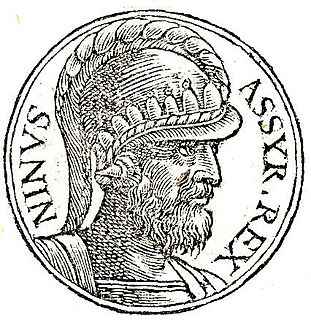 W
WNinus, according to Greek historians writing in the Hellenistic period and later, was the mythical founder of Nineveh, ancient capital of Assyria. His name is not attested on the Assyrian King List or in any cuneiform literature; he does not seem to represent any one personage known to modern history, and is more likely a conflation of several real and/or fictional figures of antiquity, as seen to the Greeks through the mists of time.
 W
WPirkei de-Rabbi Eliezer is an aggadic-midrashic work on the Torah containing exegesis and retellings of biblical stories. According to Jewish Encyclopedia it was composed in Italy shortly after 830. Scholars unanimously agree that Pirke de-Rabbi Eliezer is a work of the 8th or 9th century. The earliest citation of it is in a fragment from Pirqoi ben Baboi.
 W
W"Raphèl mai amècche zabì almi" is a verse from Dante's Inferno, XXXI.67. The verse is shouted out by Nimrod, one of the giants who guard the Ninth Circle of Hell. The line, whose literal meaning is uncertain, is usually interpreted as a sign of the confusion of the languages caused by the fall of the Tower of Babel.
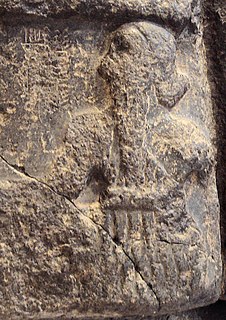 W
WSargon of Akkad, also known as Sargon the Great, was the first ruler of the Akkadian Empire, known for his conquests of the Sumerian city-states in the 24th to 23rd centuries BC. He is sometimes identified as the first person in recorded history to rule over an empire.
 W
WSemiramis was the mythological Lydian-Babylonian wife of Onnes and Ninus, succeeding the latter to the throne of Assyria, as in the fables of Movses Khorenatsi.
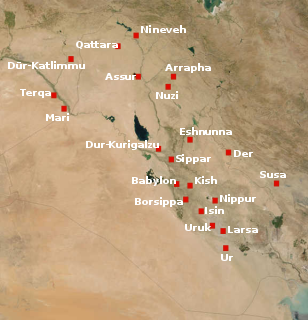 W
WShinar is the southern region of Mesopotamia in the Hebrew Bible.
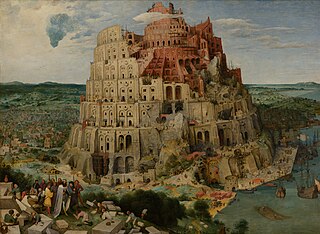 W
WThe Tower of Babel narrative in Genesis 11:1–9 is an origin myth meant to explain why the world's peoples speak different languages.
 W
WThe Tower of Babel was the subject of three paintings by Pieter Bruegel the Elder. The first, a miniature painted on ivory, was painted while Bruegel was in Rome and is now lost. The two surviving paintings, often distinguished by the prefix "Great" and "Little", are in the Kunsthistorisches Museum, Vienna and the Museum Boijmans Van Beuningen in Rotterdam respectively. Both are oil paintings on wood panels.
 W
WThe Two Babylons, subtitled Romanism and its Origins, is a religious pamphlet published in 1853 by the Presbyterian Free Church of Scotland theologian Alexander Hislop (1807–65).